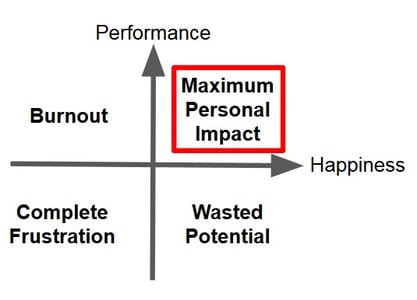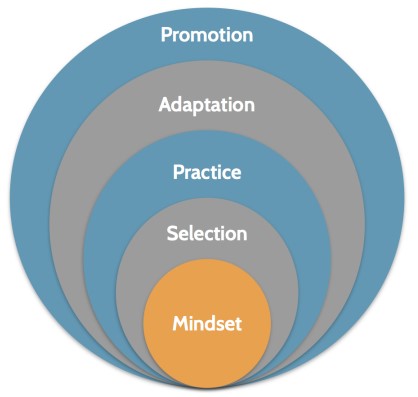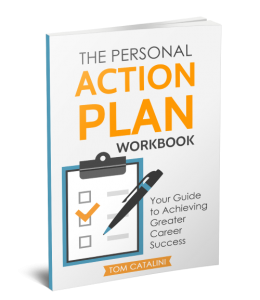Your day-to-day demands are probably the biggest problem you face as a leader. Not because it’s so hard to constantly increase your productivity, but because chasing productivity is a trap.
Productivity is task-oriented, not impact-oriented. And probably the last thing you need to worry about is becoming a more efficient task doer. Instead, you need to become more impactful.
Here’s the deal.
You operate at your best when your performance is high and your happiness is high. That’s when you are in a position to have what I like to call maximum personal impact.
Yes, productivity is a component of your performance. But over-performing at the expense of your happiness is both temporary and bad.
Maximum Personal Impact
Let’s look at the dynamics on a simple double-axis chart.
 If your performance is high, but your happiness is low, you’re on the road to burnout.
If your performance is high, but your happiness is low, you’re on the road to burnout.
If your happiness is high but your performance is low, you’re not on easy street. You’re wasting your potential. That’s no way to have an impact.
If your performance is low and your happiness is low, you end up in a spiral of complete frustration. Time to regroup and come up with a new plan.
But if your performance is high and your happiness is high, there is no limit to what you can achieve. You put yourself on a self-reinforcing positive trajectory.
Now, let’s talk about how you can start to unlock that potential.
Personal Growth and Skills
As I write in my latest publication, The Personal Action Plan Workbook, your path to happiness at work is all about personal growth. Humans are motivated by progress. When we don’t feel progress, we are less happy. So the key is to get on a path of personal growth that is ongoing. There are five keys to doing this, illustrated in the following diagram.

Working from the center out, first you must establish the right mindset for success and personal empowerment.
Next, you need to make strategic selection of specific skills to develop and enhance.
Then, you can adopt effective methods to practice new and developing skills.
From there, you move to adapt your new and improved skills into your work.
And finally, you capture value and build confidence by socializing your experience and improving your personal brand through promotion.
Let’s dig a little deeper into the topic of skills selection, which is particularly important for IT leaders.
An Ideal Skills Mix
An ideal skills mix for maximum personal impact includes hard skills, relationship skills, and leadership skills.
Hard Skills are the specific abilities you have to perform various tasks and functions. They can be easily defined and measured. These are what you might think of most prominently when you think of a role. For example, a software engineer has programming skills.
Relationship Skills are the capabilities you have to build and maintain good working relationships with others, including those outside of your organization and across your professional network. These tend to be soft skills that are more difficult to define and measure, but they are equally important.
Leadership Skills are the tools and techniques you have to lead people, projects, and teams. This is the ability to get work done through others. It’s also the ability to lead yourself in a productive and effective manner. To reach high levels of success, you need to be a good “CEO of you.”
 As you can see, each area is important, but achieving higher levels of success will require you to combine skills from all 3 arenas.
As you can see, each area is important, but achieving higher levels of success will require you to combine skills from all 3 arenas.
It’s important that you have expertise and experience in some hard skills. That’s where most of us began our careers in IT. But it’s not enough. In fact, it can be exactly the thing that limits a person’s progress. Keeping up on hard skills is always important.
Your ability to get along with others can make or break you. Nobody likes even the most seasoned expert if they don’t play well with others. Ever work with a grumpy developer? Or a sassy project manager? Maybe an aloof help desk manager?
And, even if you can combine those two skill sets, you must be able to lead. The ability to effectively lead yourself, other people, and teams is what will magnify your impact. The person who knows what they are doing and gets along with everyone still can only accomplish so much if they lack the ability to organize people, ideas, and energy toward big goals. This is probably the main job of readers of this blog.
But leadership alone is insufficient.
Even if you’ve reached heights of leadership, you must continue to hone and develop your relationship skills and your hard skills. Maybe your hard skills don’t need to be technical IT specialties. But they probably include things like improving writing skills, speaking skills, spreadsheet skills, and other mechanics required to maximize your personal impact.
And certainly you cannot allow your relationship skills to stagnate. As a leader, you must be able to convince, cajole, and influence people in all ranks of your organization (and beyond) in new and effective ways.
An Upward Spiral
Your day-to-day job is busy and hectic. But you don’t have to let it become overwhelming.
The key is to not fall into the trap of more and more task-oriented optimization. That’s the fast lane to burnout.
What you should do instead is overlay a personal strategy in order to achieve maximum personal impact. Which requires that you focus on your personal growth as much as you focus on your work.
This is not a selfish strategy, but rather a well-balanced strategy. Your team and your organization gets more value from your high impact. Your personal growth fuels your happiness. And, both the results of your impact and the complete inventory of highly-developed skills go on your resume and travel with you wherever you may land in the future.
Achieve more now, and in the future, by positioning for maximum personal impact.

Written by Tom Catalini
Tom Catalini is CIO of the Museum of Fine Arts in Boston, MA. He is the author of Career Leap Year: 52 Ways To Reach A New Level of Success, and manages the online resource Work Smarter Stress Less.



